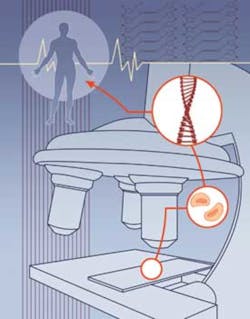Implementing an AP solution that integrates with your hospital’s LIS can improve workflow and productivity.
Pathology departments and laboratories within hospitals are vitally linked in their workflow, and often serve hundreds of personnel within a healthcare organization. Automating many of the processes, and reducing or eliminating redundancies between the systems, can result in tremendous productivity improvements and benefits.
Implementing an AP solution that integrates with your hospital’s LIS can improve workflow and productivity.
Pathology departments and laboratories within hospitals are vitally linked in their workflow, and often serve hundreds of personnel within a healthcare organization. Automating many of the processes, and reducing or eliminating redundancies between the systems, can result in tremendous productivity improvements and benefits.
Henry Ford Health Systems and Hospitals (HFHS), whose doctors are routinely named among America’s best, ranks sixth nationally in the Top 50 Exceptional U.S. Hospitals listing by Consumers Digest. The hospitals cover a tri-county area around Detroit and include the Henry Ford Hospital, Henry Ford Cottage Hospital, Henry Ford Wyandotte Hospital, Henry Ford Macomb Hospital, Henry Ford Macomb Hospital-Warren Campus, Henry Ford Kingswood Hospital and Henry Ford West Bloomfield Hospital.
Problem
When I first started at HFHS in 2003, we didn’t have a true anatomic pathology information system. We were using an anatomic pathology module, but it had limited management reports, the patient reports were not very pretty and it had no ability to attach images. We also had a variety of business problems we were trying to solve that centered on trying to improve our overall efficiency, increase our ability to extract information, enhance patient reporting capabilities and shorten our turnaround times (TAT). Our goal was to modernize and automate the pathology department as much as possible.
Criteria
Choosing an anatomic pathology (AP) information system was a strategic long-term decision and commitment for HFHS. We based our decision primarily on how well the AP system would integrate with our current laboratory information system (LIS). The technology of the information system also had to be a rock solid, modern, relational database platform. After an informal review and consideration of several other solutions on the market, Sunquest’s CoPathPlus was the only product for which we submitted a formal RFP. It met or exceeded our requirements and priorities, and we felt it was the most thoroughly fleshed out anatomic pathology system available.
We already had a very good relationship with Sunquest in terms of doing development projects, which was fortunate as there were several unique things we wanted added to the AP system — an interface for structured data reporting, for example, the first version of which was developed as part of our implementation.
The Implementation
A “normal” implementation of an AP solution for a small hospital usually takes around six months. However, a large-scale AP implementation is quite complex because it is widespread, with numerous departments and people being affected by the system, including training people across the entire organization on the new system. Therefore, a “normal” timeline doesn’t often apply. It is more important to do the job well than fast. In HFHS’s case, we were in for big changes.
The AP system implementation was more sophisticated and larger than most, and also included custom development of a structured data reporting module. Approximately 2.5 million anatomic pathology cases and reports were taken from our legacy system and converted into electronic files in the CoPathPlus database. Pathology labs rely heavily on prior reports when reviewing cases, which are especially important when the patient has a history of cancer, so this was a critical step for us.
The overall system implementation included anatomic pathology, surgical pathology, autopsy, hematology, cytology and the histology lab. Reports from hematology, flow cytometry and molecular diagnostics were transitioned into the AP system. In addition, we trained hundreds of staff. In the end, it took approximately 2 years before the system went fully live, which is not uncommon for an implementation of this complexity.
Improved Efficiency
Henry Ford Hospital is one of the most technologically progressive health system networks in the country. Major universities that are considered thought leaders in pathology informatics are amazed during visits to our sites when they see the scope and effectiveness of our implementation.
Two hundred lab pathology personnel doing anatomic pathology, 30 pathologists, 15 residents, and approximately 1,500 physicians who receive anatomic pathology data, results and reports immediately benefited from the implementation of the AP system. After the implementation, HFHS’s case volume increased to approximately 134,000 cytology surgical cases per year, not including outlying hospitals.
For more information on
Sunquest’s CoPathPlus
We utilize a continuous process improvement system, which is based on the Toyota Production System principles, but which we call the Henry Ford Production System. It’s similar to “lean” or “Six Sigma” process improvement techniques, but with a focus on organizational culture as well as process improvements. It requires constant analysis and evaluation of what our different departments and personnel are doing, and how we interact to do our work. In particular, our laboratory workflow is extremely well mapped out in a granular way with charts and graphics to map out defects, which enables us to implement improved processes and procedures. It’s not all about raw volumes, but about how much of the system is utilized. In this respect, we fully and thoroughly utilize the AP system. Much of our improved efficiencies came from eliminating and reducing repetitive efforts and replacing multiple subsystems and multiple databases.
For example, we now enter frozen section data directly into the AP system instead of maintaining a separate database. We can also order electronic histology orders, stains and special studies directly out of the AP system, while automatically maintaining histology logs. Many billing processes are now automated, and we’ve also reduced internal lab identification errors by 85 percent, by integrating a bar-coding system.
Twenty-four-hour TATs for biopsies are down from two to three days with improved clarity and completeness in surgical pathology reports. There is significant reduction in amended reports; we decreased transcription requirements by 80 to 90 percent; we’ve eliminated repetitive work, such as manually labeling histology slides and cassettes. Additionally, we’ve integrated anatomic pathology cases into our EMR, which resulted in immediate clinical availability and decreased requirements for paper report printing and distribution.
These improvements have forced us to redesign our TAT’s to report in units of hours, instead of days.
Future Plans
With our continued growth and expansion, HFHS plans to support additional customers through the services of our pathology and laboratory medicine product line. I expect we will also continue working with Sunquest to develop new features and functionality for CoPathPlus.
Choosing an anatomic pathology (AP) information system was a strategic long-term decision and commitment for HFHS. We based our decision primarily on how well the AP system would integrate with our current laboratory information system.
We also plan to continue to implement additional sites and to bring additional functionality online as time and budgetary constraints allow. This includes adding AP imaging with picture archiving and communications system integration; adding an inbound orders interface between the AP system and our electronic medical record, so that AP orders flow directly into the system; and, new tracking methods for surgical pathology specimens.
Recommendations
Don’t try to do everything at once, don’t underestimate the complexity of training, and, don’t underestimate your own lack of understanding of your own workflow and work processes in the laboratory, because most people really don’t know what the heck people are doing in the labs. Build a very careful communications structure and involve all parties. This includes top-down and bottom-up communications. Adjust the workflow to fit the information system and not the information system to fit your bad workflow.
Lastly, realize that once you go live on a system, it’s just the beginning — not the end.




